Flow Cytometry Technique Assessed for Signaling Pathways
|
By LabMedica International staff writers Posted on 24 Apr 2018 |

Image: The Navios clinical flow cytometer (Photo courtesy of Beckman Coulter).
Platelet aggregation is a key parameter in arterial thrombosis, leading to myocardial infarction or ischemic stroke. Platelets have several receptors sensitive to different stimuli and drugs that modulate aggregation with potential critical clinico-pathological significance.
Platelet intracellular signaling is essential for platelet function but difficult to study because of the small size and the need for delicate manipulation of platelets and because the reference techniques require large cell volumes and sample preparation. Flow cytometry is often used in routine clinical laboratories.
A team of scientists collaborating with CHU Saint-Etienne, Hôpital Nord (Saint-Etienne, France) assessed degree of platelet vasodilator-stimulated phosphoprotein (VASP) phosphorylation on patients hospitalized for a non-cardio-embolic ischemic stroke, included in an observational study. The patients, 12 men, seven women with a mean age of 72 years, were enrolled in the study between November 2014 and September 2015, and were treated orally with a regular daily dose of 75 mg of clopidogrel for at least five days to be at steady state, before blood was drawn.
The VASP assay was performed using the PLT VASP/P2Y12 kit. In addition, the Platelet PerFix flow cytometry method was developed from the PerFix EXPOSE kit provided for leukocytes. The team adapted the manufacturer's instruction for this kit. The fixation, permeabilization, staining and washing reagents of the kit were used. Each step was performed at room temperature. Platelets were analyzed on a Navios cytometer using Navios software (Beckman-Coulter) within one hour after the preparation was completed. Maximum platelet aggregation induced by adenosine diphosphate (ADP) was measured by Light Transmittance Aggregometry or LTA.
The investigators found poor agreement between prevention by adenosine diphosphate (ADP) of PGE1-induced cAMP-mediated VASP phosphorylation and ADP induced aggregation assessed by Light Transmittance Aggregometry. They did find a significant correlation between the PLT VASP/P2Y12 kit and the PerFix EXPOSE kit. The PerFix EXPOSE kit may also be helpful to monitor adverse effects of second-generation tyrosine kinase inhibitors on platelets as this new method can detect low responders to clopidogrel. The study was published originally on-line on February 16, 2018, in the journal Practical Laboratory Medicine.
Related Links:
CHU Saint-Etienne
Platelet intracellular signaling is essential for platelet function but difficult to study because of the small size and the need for delicate manipulation of platelets and because the reference techniques require large cell volumes and sample preparation. Flow cytometry is often used in routine clinical laboratories.
A team of scientists collaborating with CHU Saint-Etienne, Hôpital Nord (Saint-Etienne, France) assessed degree of platelet vasodilator-stimulated phosphoprotein (VASP) phosphorylation on patients hospitalized for a non-cardio-embolic ischemic stroke, included in an observational study. The patients, 12 men, seven women with a mean age of 72 years, were enrolled in the study between November 2014 and September 2015, and were treated orally with a regular daily dose of 75 mg of clopidogrel for at least five days to be at steady state, before blood was drawn.
The VASP assay was performed using the PLT VASP/P2Y12 kit. In addition, the Platelet PerFix flow cytometry method was developed from the PerFix EXPOSE kit provided for leukocytes. The team adapted the manufacturer's instruction for this kit. The fixation, permeabilization, staining and washing reagents of the kit were used. Each step was performed at room temperature. Platelets were analyzed on a Navios cytometer using Navios software (Beckman-Coulter) within one hour after the preparation was completed. Maximum platelet aggregation induced by adenosine diphosphate (ADP) was measured by Light Transmittance Aggregometry or LTA.
The investigators found poor agreement between prevention by adenosine diphosphate (ADP) of PGE1-induced cAMP-mediated VASP phosphorylation and ADP induced aggregation assessed by Light Transmittance Aggregometry. They did find a significant correlation between the PLT VASP/P2Y12 kit and the PerFix EXPOSE kit. The PerFix EXPOSE kit may also be helpful to monitor adverse effects of second-generation tyrosine kinase inhibitors on platelets as this new method can detect low responders to clopidogrel. The study was published originally on-line on February 16, 2018, in the journal Practical Laboratory Medicine.
Related Links:
CHU Saint-Etienne
Latest Hematology News
- MRD Tests Could Predict Survival in Leukemia Patients
- Platelet Activity Blood Test in Middle Age Could Identify Early Alzheimer’s Risk
- Microvesicles Measurement Could Detect Vascular Injury in Sickle Cell Disease Patients
- ADLM’s New Coagulation Testing Guidance to Improve Care for Patients on Blood Thinners
- Viscoelastic Testing Could Improve Treatment of Maternal Hemorrhage
- Pioneering Model Measures Radiation Exposure in Blood for Precise Cancer Treatments
- Platelets Could Improve Early and Minimally Invasive Detection of Cancer
- Portable and Disposable Device Obtains Platelet-Rich Plasma Without Complex Equipment
- Disposable Cartridge-Based Test Delivers Rapid and Accurate CBC Results
- First Point-of-Care Heparin Monitoring Test Provides Results in Under 15 Minutes

- New Scoring System Predicts Risk of Developing Cancer from Common Blood Disorder
- Non-Invasive Prenatal Test for Fetal RhD Status Demonstrates 100% Accuracy
- WBC Count Could Predict Severity of COVID-19 Symptoms
- New Platelet Counting Technology to Help Labs Prevent Diagnosis Errors
- Streamlined Approach to Testing for Heparin-Induced Thrombocytopenia Improves Diagnostic Accuracy
- POC Hemostasis System Could Help Prevent Maternal Deaths
Channels
Clinical Chemistry
view channel
Blood Test Could Predict and Identify Early Relapses in Myeloma Patients
Multiple myeloma is an incurable cancer of the bone marrow, and while many patients now live for more than a decade after diagnosis, a significant proportion relapse much earlier with poor outcomes.... Read more
Compact Raman Imaging System Detects Subtle Tumor Signals
Accurate cancer diagnosis often depends on labor-intensive tissue staining and expert pathological review, which can delay results and limit access to rapid screening. These conventional methods also make... Read moreMolecular Diagnostics
view channel
Blood Test Combined with MRI Brain Scans Reveals Two Distinct Multiple Sclerosis Types
Multiple sclerosis (MS) affects more than 2.8 million people worldwide, yet predicting how the disease will progress in individual patients remains difficult. Current MS classifications are based on clinical... Read more
Ultra-Sensitive Blood Biomarkers Enable Population-Scale Insights into Alzheimer’s Pathology
Accurately estimating how many people carry Alzheimer’s disease pathology has long been a challenge, as traditional methods rely on small, clinic-based samples rather than the general population.... Read more
Blood Test Could Predict Death Risk in World’s Most Common Inherited Heart Disease
Hypertrophic cardiomyopathy (HCM) is the world’s most common inherited heart condition and affects millions of people globally. While some patients live with few or no symptoms, others develop heart failure,... Read moreImmunology
view channel
Ultrasensitive Liquid Biopsy Demonstrates Efficacy in Predicting Immunotherapy Response
Immunotherapy has transformed cancer treatment, but only a small proportion of patients experience lasting benefit, with response rates often remaining between 10% and 20%. Clinicians currently lack reliable... Read more
Blood Test Could Identify Colon Cancer Patients to Benefit from NSAIDs
Colon cancer remains a major cause of cancer-related illness, with many patients facing relapse even after surgery and chemotherapy. Up to 40% of people with stage III disease experience recurrence, highlighting... Read moreMicrobiology
view channel
New UTI Diagnosis Method Delivers Antibiotic Resistance Results 24 Hours Earlier
Urinary tract infections affect around 152 million people every year, making them one of the most common bacterial infections worldwide. In routine medical practice, diagnosis often relies on rapid urine... Read more
Breakthroughs in Microbial Analysis to Enhance Disease Prediction
Microorganisms shape human health, ecosystems, and the planet’s climate, yet identifying them and understanding how they are related remains a major scientific challenge. Even with modern DNA sequencing,... Read morePathology
view channel
Genetics and AI Improve Diagnosis of Aortic Stenosis
Aortic stenosis is a progressive narrowing of the aortic valve that restricts blood flow from the heart and can be fatal if left untreated. There are currently no medical therapies that can prevent or... Read more
AI Tool Simultaneously Identifies Genetic Mutations and Disease Type
Interpreting genetic test results remains a major challenge in modern medicine, particularly for rare and complex diseases. While existing tools can indicate whether a genetic mutation is harmful, they... Read more
Rapid Low-Cost Tests Can Prevent Child Deaths from Contaminated Medicinal Syrups
Medicinal syrups contaminated with toxic chemicals have caused the deaths of hundreds of children worldwide, exposing a critical gap in how these products are tested before reaching patients.... Read more
Tumor Signals in Saliva and Blood Enable Non-Invasive Monitoring of Head and Neck Cancer
Head and neck cancers are among the most aggressive malignancies worldwide, with nearly 900,000 new cases diagnosed each year. Monitoring these cancers for recurrence or relapse typically relies on tissue... Read moreTechnology
view channel
Pioneering Blood Test Detects Lung Cancer Using Infrared Imaging
Detecting cancer early and tracking how it responds to treatment remains a major challenge, particularly when cancer cells are present in extremely low numbers in the bloodstream. Circulating tumor cells... Read more
AI Predicts Colorectal Cancer Survival Using Clinical and Molecular Features
Colorectal cancer is one of the most common and deadly cancers worldwide, and accurately predicting patient survival remains a major clinical challenge. Traditional prognostic tools often rely on either... Read moreIndustry
view channel
BD and Penn Institute Collaborate to Advance Immunotherapy through Flow Cytometry
BD (Becton, Dickinson and Company, Franklin Lakes, NJ, USA) has entered into a strategic collaboration with the Institute for Immunology and Immune Health (I3H, Philadelphia, PA, USA) at the University... Read more




















